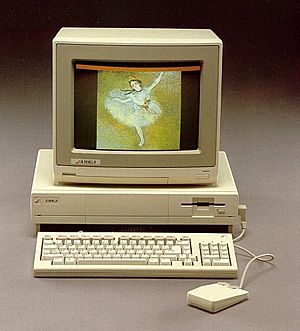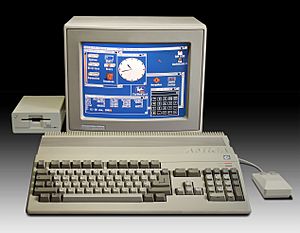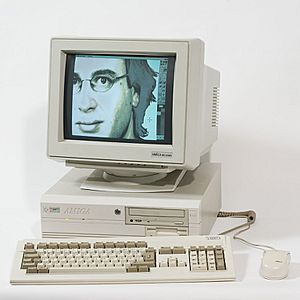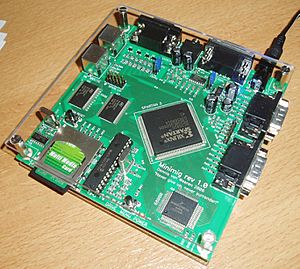History of the Amiga facts for kids
The Amiga is a family of personal computers. They were designed and sold by the Amiga Corporation and later by Commodore Computing International. These computers were popular from 1985 to 1994.
Contents
Amiga Corporation: How it Started
The Amiga's special computer chips, called the Original Chip Set, were designed by the Amiga Corporation. This happened around the time the first home video game craze was ending. The team used a powerful computer called "Agony" to help design these chips.
Amiga Corp. earned money to develop these chips by making game controllers. They also got a loan from Atari, Inc. while looking for more investors. The original plan was to use the chips in a video game machine. But after the big video game crash of 1983, they changed their minds. They decided to make the Amiga a personal computer that could do many things at once and handle different types of media like sound and pictures.
The company showed a test version of the Amiga in January 1984. They hoped to find people to invest money. BYTE magazine reported in April 1984 that the Amiga would have 128KB of memory and a floppy disk drive. It was expected to sell for less than $1000 later that year.
More presentations were made in June 1984 to big companies like Sony, Hewlett-Packard, Philips, and Apple Inc.. Steve Jobs from Apple, who had just launched the Macintosh, saw the Amiga prototype. He thought it had too much hardware, even though the new design used only three main chips. Investors became careful about new computer companies. This was because the IBM PC was becoming very dominant. Jay Miner, a co-founder and lead engineer, even took out a second loan on his house to keep the company from going broke.
In July 1984, Jack Tramiel, the former head of Commodore International, bought Atari Inc. Many Commodore employees followed him. This led to a lawsuit from Commodore. Tramiel's son later found out that Atari Inc. had lent $500,000 to Amiga Corporation. This loan was due at the end of June.
Soon after, the Amiga group started talking with Commodore about selling their company. In August 1984, Commodore bought Amiga for $27 million. This included paying off the loan from Atari.
Commodore: The Amiga Years
The Early Years: 1985–87
The first Amiga computer was released in July 1985 by Commodore International. It was simply called the Amiga 1000. Commodore marketed it as the next step after their popular Commodore 64. They also saw it as a competitor to the Apple Macintosh. It was later renamed the Commodore Amiga 1000.
The Amiga 1000 had a base price of about $1295 in 1985. It could show up to 4,096 colors and play 8-bit stereo sound. It could also run several programs at the same time. These features were amazing for a home computer back then. This gave the Amiga 1000 a big lead over its main competitors: the Atari ST, the Macintosh, and the IBM PC.
Many people saw Commodore and Atari as companies that sold "cheap" game machines. Observers thought either the Atari ST or the Amiga would survive, but not both. The Atari ST had more software at first. But bigger companies like Electronic Arts promised to make software for the Amiga. Neither computer was sold in major stores like ComputerLand. They also didn't have support from big business software companies like Microsoft. The New York Times wondered if business users cared about colorful graphics. The Amiga's amazing graphics made people think of it more as a "game machine."
The Amiga 1000 was not very successful because it was not marketed well. In August 1986, Compute! magazine was surprised that Commodore didn't show the Amiga at a big electronics show. This was because Commodore insisted it was a business computer. The magazine estimated that the Atari ST had sold more than the Amiga in their first year.
By 1987, rumors spread that software makers were disappointed with Amiga sales. Bing Gordon of Electronic Arts said the Amiga "never did as well as we had hoped." He added that Amiga games sold about 25,000 copies in 1986. This was much less than the 125,000 to 150,000 copies for the Commodore 64. In 1994, BYTE magazine wrote that "The Amiga was so far ahead of its time that almost nobody... could fully explain what it was." They said it was the first multimedia computer. But back then, it was called a game machine because few understood the importance of its advanced graphics, sound, and video. This marketing confusion affected the Amiga throughout its life.
Cheaper and High-End Models: 1987–90
In 1987, Commodore released two new Amiga models. The Amiga 500 was cheaper at US$699. The Amiga 2000 was a high-end model for US$2395. This price included 1 MB of memory and a monitor.
By 1988, software sales for the Amiga were still lower than for the IBM PC. But with its lower price, the Amiga 500 became a very successful home computer. It eventually sold more than its main rival, the Atari ST. The Amiga 2000 also found a special use in desktop video because it could connect to video equipment. This market was not as big as the office market dominated by the IBM PC. The Amiga 2000 sold fewer units than those systems. The Amiga was widely used in TV and video production in the late 1980s and early 1990s. It was even used on popular shows like Clarissa Explains It All.
Peak Popularity: 1990–92
In 1990, Commodore released a big update to the Amiga platform. This was the Amiga 3000. It had an improved chipset (ECS) and a new version of its operating system, called Workbench 2.0.
Commodore had a poor reputation among customers and software makers. Computer Gaming World wrote in 1990 about their "terrible record of customer and technical support." Commodore struggled to keep up with the fast improvements of PCs. This was because they had fewer resources. Users complained that the ECS chips didn't match the features of PC and Mac displays at the time.
On the good side, many users thought the Amiga 3000 was the best-designed Amiga model. Its built-in filter made it easy to use cheaper PC-style monitors. This might be why Commodore sold one million Amigas in just one year. This was a third of all Amigas sold up to that time.
In the same year as the Amiga 3000, Commodore released the US$895 CDTV. This system was meant to bring the Amiga into the living room. It competed with devices like Philips CD Interactive. Commodore thought there was a market for a system that could show animations and pictures. It could also offer educational software and games on a TV. The CDTV was basically an Amiga 500 with a remote control instead of a keyboard. It had a CD-ROM drive instead of a floppy drive.
The Amiga 500 was cheaper and more flexible. Few Amiga users were interested in the CDTV. Also, the general public preferred cheaper game consoles. They were not aware of the multimedia potential of these CD-ROM systems. The CDTV became Commodore's first Amiga-based failure. It cost them a lot of money.
Trouble Ahead: 1992–94
Commodore started 1992 by releasing the Amiga 500+. This was a slightly updated and cheaper Amiga 500. This model was seen mostly as a game machine, especially in Europe. But it was criticized for not being able to run popular games. Some people even returned them, asking for the original Amiga 500.
By the early 1990s, the IBM PC was the leader in computer games. In December 1992, Computer Gaming World reported that MS-DOS computers made up 82% of game sales in 1991. The Amiga was only 5%. Commodore wanted the Amiga 500 and 500+ to take the place of the Commodore 64 in the low-cost market. To do this, they designed the Amiga 600, which was meant to be much cheaper than the Amiga 500. The Amiga 500 itself would be replaced by the Amiga 1200, which was also being developed.
Shortly after releasing the Amiga 600, Commodore announced that two new "super Amigas" would be released later that year. This made consumers wait for the new models. As a result, sales dropped, and Commodore had to close their Australian office. At the same time, Commodore's attempt to enter the PC market was not successful. This caused Commodore's profits to fall to $28 million in 1992. This made a successful launch of the new Amigas even more important.
In October 1992, Commodore released the Amiga 1200 and the Amiga 4000. Both had the new AGA chipset and the third version of AmigaOS.
Computer Gaming World reported in March 1993 that Amiga sales were falling. This caused many US software makers to stop making Amiga games. In July, at a big European computer show, the Amiga was "hardly mentioned." That year, Commodore marketed the CD32. This was one of the first CD-based game consoles. It was also the world's first 32-bit game machine. Its features were similar to the A1200.
The very last Amiga computer released by Commodore was the A4000T in 1994.
Amiga in the United States
Mass-market Amigas were much cheaper than PCs and Macintoshes at the time. This helped sales in Europe. But in the US, it made Commodore seem like a maker of cheap "toy computers" or "game machines." This idea was also spread because most Commodore stores were toy stores. Their marketing didn't match what the public wanted. Overall, the Amiga was very successful in Europe. But it sold less than a million units in the US.
In the US market, the IBM PC was already very popular, especially in workplaces. People often asked, "Is it IBM compatible?" This was so they could "take work home." To help with this, Commodore offered PC-compatibility add-ons. These included the Amiga Sidecar for the Amiga 1000. They also had a 5.25" floppy disk drive to share data with PC disks.
Even as Commodore improved the Amiga's compatibility, PC graphics got much better. This led to many PC games being released. Consumers started to see no advantage in the Amiga's "different" technology. Commodore's efforts didn't convince users to buy an Amiga. Instead, cheap PC clones started to fill the US market. As a result, US Amiga users were often people who loved technology. They might have been loyal Commodore fans, or people who worked with video and graphics. The desktop video market was one of the few areas where the Amiga became widely used in the US outside of homes.
Bankruptcy
Commodore management decided to file for Chapter 11 bankruptcy in April 1994. This US law allows a company to recover from debts and reorganize. Commodore had been reorganized before. But this time, the court-appointed board decided to close the company. Most of Commodore's assets and name were sold to Escom. Production stopped briefly. Then it restarted for a short time under Escom's Amiga Technologies. Even though the machines were updated, the lack of new Amigas meant that sellers eventually moved on. Most technology fans moved to PC computers.
Because some Amiga fans were very loyal, the Amiga community continued for many years. Eventually, the PC became the leading home computer. The console wars also left the CD32 behind.
The rights to the Amiga platform were sold to Escom. Later, they were sold to Gateway 2000. Escom went bankrupt soon after due to other problems. Gateway decided to keep the patents. They sold the remaining parts to a new company, which was renamed Amiga, Inc. in 1999. Amiga Inc. sold the copyrights for older works to Cloanto. They also hired Hyperion Entertainment to develop AmigaOS 4.
New Amigas: Keeping the Legacy Alive
Since the original Commodore-Amiga computers stopped being made, many attempts have been made to create new Amiga hardware. All new Amigas are built from standard parts. They do not use the original custom chips from Commodore.
Amiga Compatible Machines
Some Amiga-compatible machines share the original Amiga's heritage. They can work with the custom chips. While they don't use the exact original chips, they create similar functions using special chips called FPGAs or custom programs.
DraCo
The DraCo was the first Amiga "clone." It was released in 1994 when Commodore International went bankrupt. It was sold until 2000. The DraCo didn't use FPGAs for the custom chips. Instead, it made sure its operating system could work with Amiga programs. It was not meant to be a general computer. However, users could get some models to start up to the Workbench desktop.
Minimig
Minimig is an open-source project that recreated the Amiga 500. It uses an FPGA for the custom chips. It was released under the GNU General Public License. It uses a MC68000 CPU chip and can run faster than its original speed. The size of the FPGA limited the MiniMig. It could only do some of the ECS graphics. It was also limited to 2 MB of memory.
Natami
Natami was a project to build computers based on the 68k processor to run AmigaOS. The original project is no longer active. But many of the main people from Natami moved on to the Vampire project.
Vampire V4 Standalone
The Vampire V4 Standalone is an FPGA Amiga-compatible system. It is being developed by Apollo Accelerators. It uses the Apollo Core 68080 (AC68080) chip. This chip was first used in the V2 line of accelerators. These accelerators work with the Amiga 500 and Amiga 600. The V500 has also been put into the original Amiga 1000 and Amiga 2000 computers. The V2 was designed as an accelerator. But it had its own memory, ethernet, microSD, and special graphics called "SAGA."
The V4 is designed to replace the V2 V500 model as an accelerator. It can also work completely on its own. To do this, Apollo Accelerators made their own version of the AGA chipset. They also added support for classic DB9 joysticks and USB 2.0 devices like mice, keyboards, and gamepads. Amiga AGA graphics are automatically made larger to fit HDMI (576p) screens. They can switch between classic and SAGA display modes. This allows them to be used with modern LCD monitors and TVs.
As of August 2019, the AC68080 is the fastest 680x0-compatible Amiga processor. It is more than four times faster than the previous fastest, the Motorola 68060. It can perform 192.12 MIPS and 102.06 MFLOPS. The Cyberstorm 68060 at 50 MHz could only do 39.29 MIPS and 28.02 MFLOPS. The AC68080 gets its speed from using modern DDR3 memory. This memory can transfer over 500 MiB/s. The original Amiga processors were much slower when accessing shared "chip" memory.
The AC68080 is not open source. It is designed to use the original Commodore AmigaOS. This includes the newest AmigaOS 3.1.4 release from Hyperion Entertainment. But it can also run AROS, EmuTOS, and FreeMiNT. It can even run the Classic Macintosh OS.
Amiga Components
Many suppliers have started to provide parts for users to build their own Amiga-compatible computers. This includes new motherboards and cases. These are meant to be combined with an emulator or an FPGA.
AmigaOS 4 Systems
The AmigaOS is known for combining the functions of an operating system and a window manager. It was mainly designed to run on PowerPC Amiga systems. This includes hardware with Cyberstorm PPC or BlizzardPPC accelerator boards. It also runs on AmigaOne computers with PPC Teron installed. This system was only available in test versions for several years. The final version was released in December 2006. Since 2001, Hyperion Entertainment has been developing new AmigaOS 4. It runs on PowerPC-based systems.
AmigaOS 4 also runs on the Sam440 line of computers. These were developed by ACube Systems. It also runs on Pegasos II systems and AmigaOne systems. AmigaOS 4 can run AmigaOS software written for original Commodore Amigas.
AmigaOS 4 provides a way to run older 68K software. If a program is known to be "OS-friendly" (meaning it doesn't try to directly control hardware), a lightweight emulator is used. This allows the program to use AmigaOS 4's features. If the program is not known, or tries to control hardware directly, it will run using E-UAE.
AROS Systems
AROS is an open-source version of AmigaOS. It is designed to be easily moved to different computer systems. The first versions copied the features found in AmigaOS 3.1. It runs on many x86-based systems as native or hosted versions. AROS also runs on some 68k-based Amigas and PowerPC systems. There are also sellers of 'AresOne' systems that only run AROS. Unlike many other Amiga solutions, AROS is only Amiga binary compatible on 68k-based systems. This version is known for being very compatible with the original AmigaOS at the source-code level.
MorphOS Systems
MorphOS is a closed-source version of AmigaOS. It runs on PowerPC-based systems. But it can run AmigaOS software written for the original Commodore Amigas. MorphOS runs on Efika, Pegasos I/II, and PowerPC-based Apple Mac G4 models. This includes the Mac Mini, eMac, PowerMac, PowerBook, and iBook.





